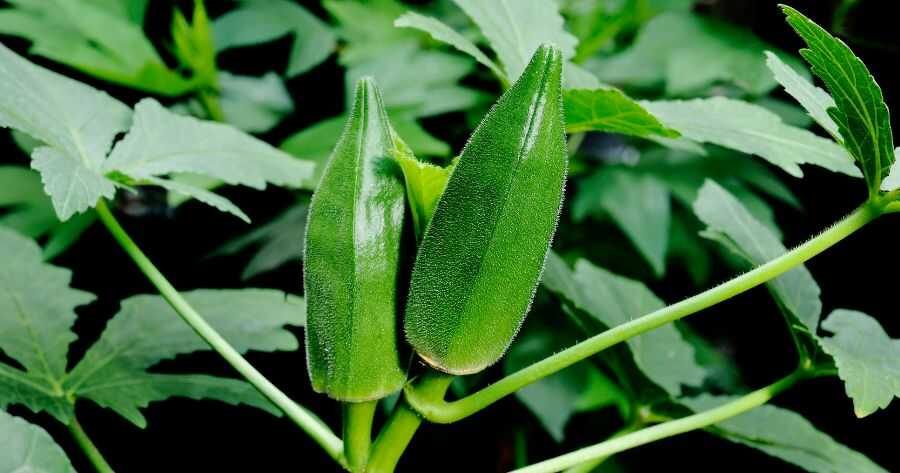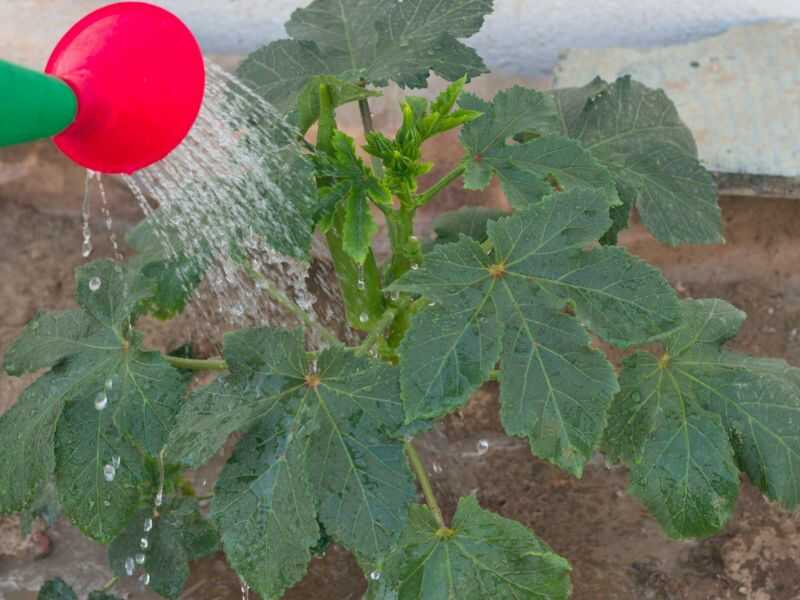
Okra is a popular vegetable in many parts of the world, especially in Africa, the Middle East, and Asia. It’s also gaining popularity in the United States as a healthy and delicious addition to many recipes. If you’re interested in growing okra, it’s not difficult to do.
In this blog post, we will walk you through the process of growing okra from seed to harvest. We will also provide some tips on how to care for your okra plants and what to do with the bounty once it’s ready to be picked.
Okra, also known as Abelmoschus esculentus, is a tropical flowering plant that is a member of the mallow family, which includes hibiscus, rose of Sharon, and cotton. Okra is an annual plant that typically grows to be about 3-6 feet tall. The okra plant produces beautiful yellow flowers that turn into green seed pods.
How to Grow Okra Plants in Your Home Garden

Okra is a common ingredients in a variety of dishes, including gumbo, stews, and soups. Okra is not only delicious, but it is also high in nutrients such as vitamins A and C, calcium, and iron. If you are thinking about adding okra to your garden, here is everything you need to know about how to grow okra from seed to harvest.
Selecting and Preparing the Seed

The first step in growing okra is selecting and preparing the seed. You can purchase okra seed from a gardening store or online. When choosing okra seeds, make sure to select a variety that is suited for your climate.
For example, if you live in an area with a long growing season, choose a long-season variety of okra such as Clemson Spineless. If you live in an area with a short growing season, choose an early-maturing variety of okra such as Dwarf Green Long Pod. There are a few things to consider when selecting okra seed:
- Good harvests start with the right seed.
- Choose high-quality, germination-rate seeds.
- Cool, dry storage is recommended.
- Soak the seeds overnight before planting.
- Rows of 1/2-inch-deep seeds should be 3 inches apart.
- Once a month, water and fertilise the plants.
Once you have selected the type of okra seed you would like to plant, it is time to prepare the seed for planting. To do this, fill a bowl with warm water and soak the seeds overnight.
This will help soften the seed coat and encourage germination. In the morning, drain the water and lightly rub the seed between your fingers to remove the husk. Once the husk has been removed, your seed is ready to plant.
Planting

Okra can be planted in either spring or summer. If you are planting in spring, start seeds indoors 4-6 weeks before the last frost date in your area. To do this, fill planting pots with potting mix and press 1–2 seeds into the soil.
Water the seeds generously and place them in a warm location, such as on top of a refrigerator or near a heat vent. Keep the soil moist but not soggy, and within 7-10 days your seeds should germinate. Once they have germinated, thin out the seedlings so that only the strongest one remains in each pot.
About 2-3 weeks before your last frost date, harden off your plants by placing them outside for a few hours each day in an area that receives full sun.
Gradually increase the amount of time they spend outside until they can remain outside all day without being damaged by frost or temperature changes. Once your plants have been hardened off, transplant them into your garden, spacing them 12–18 inches apart.
If you are planting in the summer, sow seeds directly into your garden after all danger of frost has passed and temperatures have begun to rise consistently during the day.
To do this, simply make small holes in the soil with your finger and drop 1–2 seeds into each hole before covering them lightly with soil. Water each hole generously after planting, then thin out the seedlings so that only one strong one remains per hole when they reach 4 inches tall.
Caring for Your Okra Plant

Assuming you've taken all the necessary steps to germinate and grow your okra plants, it's time to start focusing on how to care for them. Okra is a relatively easy plant to grow, but there are a few things you should keep in mind to ensure a bountiful harvest.
First and foremost, water your okra plants regularly. They should be watered deeply and evenly, about 1-2 inches per week. Try to avoid getting the leaves wet, as this can promote fungal growth.
If you live in a particularly hot or dry climate, you may need to water your lawn more often. Secondly, fertilise your okra plants every few weeks with a nitrogen-rich fertilizer. This will help promote foliage growth.
You can also add compost to the soil around your plants to give them a nutrient boost. Finally, make sure to harvest your okra regularly. This will encourage the plant to keep producing more fruit. Harvest when the pods are about 3-4 inches long for best results.
Okra Pests, Diseases and Control Measures

Okra pests can cause serious damage to your okra plants, leading to decreased yields and potential financial losses. The Hessian fly, the corn earworm, and the spotted cucumber beetle are some of the most common pests of okra.
Diseases caused by these insects can also affect other vegetables in your yard, including squash, tomatoes, and watermelons. Diseases often cause leaves to wilt or turn yellow, plant parts (especially fruit) to grow slowly or be misshapen, and flowers to not grow well.
Control measures for Okran pest problems typically involve using chemical pesticides or traps/pesticides that capture the pest larvae before they have a chance to infest your crops again. You may also want to remove any diseased plants from your garden so that they don't further spread disease among your other plants.
If you're experiencing problems with pests or diseases affecting your okra plant, there are a few things that you can do to try and solve the issue. One important step is to identify the root cause of the problem and address it accordingly. For example, if your okra plants have blight, treating the soil may be enough to get rid of it or make it less harmful to the health of the crop.
If mechanical intervention is required (such as using flea traps or insecticidal soap), make sure that you use safe and effective products so that you don't end up harming either yourself or your pets. Some common techniques include using pesticides, flooding plants with water, using a fungicide/insecticide spray, using ladybugs as natural predators, and laying down a layer of mulch around the plant.
However, it is important to test any pesticide or treatment first on an inconspicuous part of the plant before applying it more broadly. Always read and follow all safety warnings when applying these types of chemicals!
And finally, keep an eye out for any changes in behaviour among your plants; when something's wrong, they'll usually let you know! If possible, start by monitoring their water usage and temperature fluctuations before making any final decisions about pesticide application.
Harvesting

Okra is ready to harvest 50–60 days after planting, depending on the variety. Harvesting okra is a bit different than harvesting other vegetables. The pods must be picked when they are young and tender, before the seeds inside start to mature.
If you wait too long, the okra will be tough and stringy. The best time to harvest okra is in the morning, after the dew has evaporated but before the heat of the day sets in. Cut the pods from the plant with a sharp knife, being careful not to damage the plant.
If you are growing okra for its seeds, you will need to wait until the pods are fully mature and dry before harvesting. The seeds can be harvested by hand or with a combine. Once the seeds are harvested, they can be used to plant new okra plants next season.
You can eat harvested okra raw or cooked within 2-3 days after picking it for best quality and flavor. If not consumed right away, store harvested okra in a plastic baggie inside the refrigerator crisper drawer.
Frequently Asked Questions

What is the best way to grow okra?
The best way to grow okra is in a warm climate with plenty of sunshine and well-drained soil. Okra can be grown from seed or transplants. If you are growing okra from seed, start the seeds indoors about six weeks before the last frost date.
Plant the seeds 12 inches apart in moist, well-drained potting soil.Keep the soil moist but not wet and provide plenty of light. When the seedlings are 4-6 inches tall, transplant them into the garden. Space the plants 12-18 inches apart in rows that are 3-4 feet apart.
How often should I water okra?
Okra plants need water when the soil is dry to the touch. Okra plants need about 1-12 inches of water per week. Don't water the leaves of the plant because that can lead to fungal diseases. Instead, water the plant's roots.
How long does it take for okra to yield?
Okra typically takes around 2-3 months to yield, depending on the variety planted.
What is the best month to plant okra?
The best month to plant okra varies depending on your location. In general, it is best to plant okra in the spring or early summer.
In springtime, start plants indoors 4-6 weeks before the last frost date, then transplant outdoors after all danger of frost has passed. Summer sowings can be done directly into the garden once temperatures have risen consistently.
How do you know when okra is ready to harvest?
Okra is typically ready to harvest when it is 4-6 inches long and is typically ready to harvest around 60 days after planting. The fruit will be bright green and firm to the touch. The best way to tell if okra is ready to harvest is by checking the size of the pods.
Okra pods are edible when they are 3–4 inches long. If you wait too long to harvest the okra, the pods will become tough and stringy.
Conclusion
Congratulations on completing your journey of growing okra from seed to harvest! By following the steps in this article, you should have a bountiful crop of okra to enjoy. Growing your own food is a rewarding experience that will provide you with healthy and delicious vegetables for years to come.If you have any questions or need further assistance, please consult the Frequently Asked Questions section above. With a little care and attention, you will be an expert okra farmer in no time! You should now be familiar with the process of growing okra from seeds, right? - Garden Lot
Tags:
Garden
